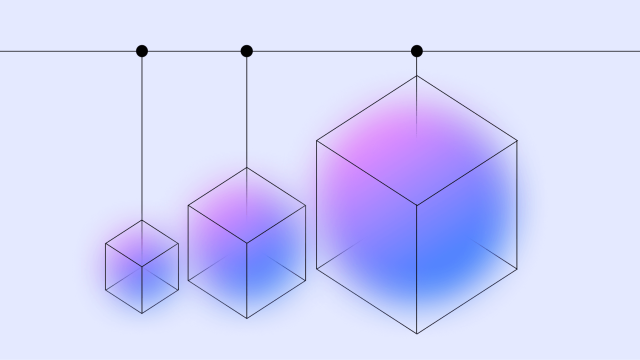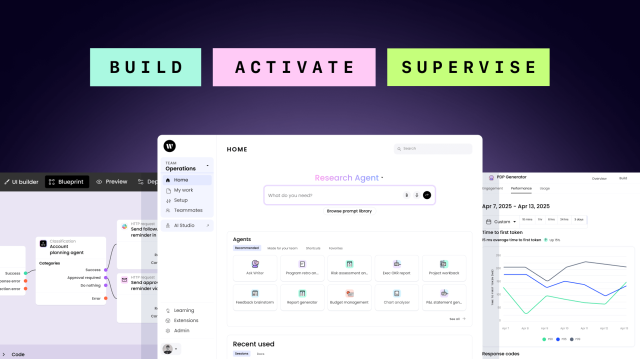AI agents at work
– 14 min read
How sales productivity AI agents are fixing the broken prospecting model

For years, I watched my most talented sellers get buried in manual prospecting, and I knew the model had to change. This is how sales productivity AI agents are finally fixing that broken process and what it means for your team’s ability to drive revenue.
- The traditional sales prospecting model doesn’t work anymore — it forces reps into months of manual, inefficient research that leads to burnout and delayed revenue.
- This inefficiency creates significant hidden costs, including unreliable forecasts, high seller turnover, and a fragmented, underutilized tech stack.
- The solution requires shifting from managing manual tasks to automating entire end-to-end prospecting workflows.
- Sales productivity AI agents execute these complex workflows autonomously, handling everything from territory planning and research to personalized outreach.
- By eliminating administrative work, AI agents empower sellers to become strategic advisors, dramatically increasing prospecting velocity and driving measurable pipeline growth.
There’s a moment I think every sales leader can recognize — handing a brand-new, ambitious Account Executive (AE) a spreadsheet with hundreds of accounts and telling them to tier their accounts and build a territory plan. For years, I saw this as a rite of passage. I thought I was giving them autonomy, a chance to own their success from day one.
It took me too long to realize that what I was actually giving them was two months of manual, soul-crushing homework. My attempt to empower them was, in reality, setting them up for failure before they ever made a single call. That moment of realization stuck with me because it’s a clear picture of a problem that quietly undermines our entire industry. It’s the true origin of the staggering 77% of time our best sellers lose to non-selling, administrative tasks. The traditional ramp-up period — once a standard onboarding process — has become a predictable cycle of burnout and delayed revenue.
The future of elite sales performance requires a new layer of intelligence that can automate the entire prospecting workflow from end to end. It’s time to arm our sellers with sales productivity AI agents that let them focus on what they were hired to do — sell.
Why is the traditional sales ramp broken?
For years, I accepted the long sales ramp as a necessary cost of doing business. But I eventually realized it wasn’t a process. It was a trap. It relied on a series of flawed assumptions that forced my reps to spend their most valuable time on the least valuable work. I saw this play out in three distinct stages.
Conventional methods provide data without direction
The process begins with an illusion. We’d hand a new rep a list of accounts, often a raw data dump from Salesforce, and call it a territory. In their hands, it became a puzzle with a thousand pieces and no picture on the box. Even with the best intent models, traditional territory management software falls short here. It organizes data beautifully but fails to answer the most critical question for a new rep: “Where do I start, and why?” This leaves them staring at a list, forced to begin the long, manual journey of finding the signal in the noise.
Standard practices demand countless hours of manual, fragmented research
Once a rep picked a handful of accounts to investigate, the real time-sink began. This was the soul-crushing, manual process of sifting through LinkedIn profiles, 10-Ks, earnings call transcripts, and press releases. Each piece of information lived on a different platform, forcing reps to jump between dozens of B2B prospecting tools and browser tabs. This fragmented workflow is the very definition of inefficiency, burning days and weeks that could have been spent talking to customers.
The traditional process encourages guesswork over genuine insight
After weeks of this grueling research, what was the result? An exhausted rep with a collection of disconnected facts instead of a deep, strategic insight. The manual effort is so draining that it leads to weak, generic hypotheses about buyer pain points. The initial hard work devolves into uninspired guesswork. The business impact is severe and predictable. The countless hours of work produce no tangible business impact on the pipeline for weeks or months.
What are the hidden costs of sales inefficiency?
The consequences of this slow, painful ramp-up eventually became impossible to ignore. What I once saw as a new-hire productivity issue, I now understood to be a systemic issue in how GTM leaders set their new hires up for failure. I felt the impact in three distinct ways.
Boardroom-level forecast anxiety
There is no worse feeling for a sales leader than sitting in a QBR, looking at a forecast you don’t trust. The deepest fear isn’t that the market has shifted — it’s that you’ll miss your number because of poor execution. When reps spend less than a third of their time actually selling, the data in your CRM becomes a lagging indicator of activity rather than a reliable predictor of revenue. This creates immense pressure from the rest of the C-suite to do more with less, and it fosters a perception that the sales organization is bloated and undisciplined — a dangerous label in any economic climate.
The high price of seller burnout and turnover
The human cost is just as damaging. I’ve hired incredibly talented, driven AEs only to watch their motivation drain away as they spend their days copying and pasting data instead of building relationships and closing deals. Top performers leave because their work isn’t strategic, not because it’s too hard. They want to use their skills to solve customer problems, not drown in administrative tasks. I firmly believe that salespeople are some of the most creative folks out there. We need to help them use their time on creativity and not administrative burdens. This constant administrative burden is a leading cause of high turnover, forcing companies into a costly, repetitive cycle of hiring and retraining.
A bloated, disconnected tech stack
The final hidden cost is the one sitting right in our budget — a tech stack that promises integration but delivers fragmentation. We’ve all spent years and millions of dollars investing in best-in-class tools like Salesforce, Gong, and Outreach. Yet, these platforms often create more silos. The underlying challenge is the absence of a true, intelligent CRM automation layer to connect the stack into a seamless workflow. Without it, our expensive tech stack just becomes part of the problem, turning a collection of powerful tools into a fragmented sales intelligence engine.
How can you shift sellers from administrative tasks to strategic work?
I kept asking myself the same question: How do I get my reps to stop acting like researchers and start acting like sellers? I couldn’t just tell them to work faster or buy another point solution. I had to change the work itself. The solution became clear when I realized we had to stop managing tasks and start automating entire workflows. This meant embracing a new class of technology.
Move beyond task management to workflow automation
The first step is a mental shift. For too long, we’ve tried to solve the productivity problem by making reps faster at manual work. The real goal should be to eliminate administrative tasks entirely. This forced me to ask a fundamental question, “Why are my reps doing this research at all?” Their highest value lies in building relationships, understanding nuance, and thinking strategically. The moment we decide that our best people shouldn’t be doing low-level work, we open the door to real transformation.
Deploy an AI sales field productivity agent
A new kind of technology powers this transformation — an AI agent. Think of it as more than a chatbot or a “copilot” that assists with a single step. An AI agent is an autonomous system designed to understand natural language commands and execute complex, multi-step sales workflows from start to finish. It can analyze a territory, identify high-potential accounts based on your ICP, conduct deep research across dozens of sources, and even draft personalized outreach. This is the foundation of true sales productivity AI — a system that manages the entire end-to-end process of field sales automation.
Elevate your reps into strategic advisors
Once the workflow is automated, the sales role fundamentally changes. With an AI agent handling the “how” of prospecting, your sellers are free to focus entirely on the “why” and the “who.” They shift from digging for data to analyzing insights and from building lists to building relationships. This allows them to apply their expertise to complex strategic frameworks like MEDDPICC, turning raw sales intelligence into a winning account planning AI strategy. You’re finally empowering them to be the strategic advisors you hired them to be.
How to transform the prospecting workflow with AI agents
My long-standing vision as an Ops leader was to create a world where a new rep had everything they needed to succeed on day one, completely eliminating the ramp slog. I imagined an automated process capable of compressing months of manual research into a few hours. With the rise of true sales productivity AI agents, that vision is now a practical reality.
Let me show you what that looks like in practice.
Step 1: Automate territory planning
It starts with a simple, natural language prompt from a sales manager to their AI agent:
“Build a territory plan for my new AE covering these 500 accounts, prioritizing for our ICP based on recent funding, hiring for engineering roles, and mentions of ‘data infrastructure’ in their earnings calls. Provide a fit score 1-100.”
Instead of spending weeks manually sorting a spreadsheet, the agent instantly analyzes the entire account list against the specific criteria of your Ideal Customer Profile. It connects to your CRM, external data sources, and financial news to rank and tier the accounts. Within minutes, the rep receives a fully prioritized territory map, transforming a mountain of data into a clear, actionable starting point. This is what modern territory management software should have been all along.
Step 2: Generate deep account research
With a prioritized list, the rep then directs the agent to the next step:
“For my Tier 1 accounts, generate a one-page summary on each, including key financials from their last 10-K, strategic initiatives mentioned in their last earnings call, and a list of VPs in the product and engineering departments.”
The agent now performs the deep research that used to consume weeks of a rep’s time. It synthesizes information from dozens of disconnected B2B prospecting tools into a concise, strategic brief for each target account. The output is pure sales intelligence. The rep immediately understands why an account is a good fit, arming them with the context needed for a credible conversation. This is the core of effective account planning AI.
Step 3: Enhance research with interactive chatbot queries
The chatbot functionality allows reps to delve deeper into the research with real-time, interactive queries. For example, after receiving the initial one-page summary, a rep can ask questions like:
“Can you provide more details on the VP of Engineering’s recent projects and any challenges they might be facing?”
“What are the key competitors of this company, and how do they compare in terms of market share and recent innovations?”
This dynamic interaction ensures that reps can continuously refine their understanding and tailor their approach to each account, making the prospecting workflow more efficient, strategic, and insightful.
Step 4: Scale personalized outreach
Now, the focus shifts from research to engagement. The rep can ask the agent: “Draft three personalized outreach emails for the VP of Engineering at Acme Corp, referencing their recent focus on cloud migration and connecting it to our value proposition.”
The agent uses the insights from its research to generate highly relevant, non-generic outreach. It moves beyond simple mail-merge fields to craft a narrative that speaks directly to the prospect’s known strategic priorities. The rep receives a ready-to-send starting point that they can review, refine, and send in minutes — a task that used to take hours — allowing them to connect with dozens of high-value prospects in a single afternoon.
Step 5: Deliver instant call prep
The agent’s value continues throughout the entire sales cycle. Five minutes before a discovery call, the rep can simply ask: “Prep me for my call with Acme Corp.”
Instantly, the agent delivers an up-to-the-minute briefing document directly to the rep. It includes the latest company news, bios on the key contacts they’re meeting with, a summary of previous interactions from your CRM, and potential talking points aligned with your MEDDPICC framework. This powerful agentic automation eliminates the frantic, last-minute scramble for information and ensures every single seller walks into every meeting prepared, confident, and ready to win.
How WRITER delivers intelligent, agentic workflow automation
Discovering WRITER was a pivotal moment. I immediately recognized the platform I had been trying to build in my head for years — a cohesive system to replace the patchwork of tools I’d been using. It delivers true end-to-end workflow automation through a full-stack architecture, fundamentally changing the speed of execution. This is possible because of a few key technological differentiators.
By analyzing accounts against your unique business criteria
Through AI HQ, the agent begins by deeply understanding the nuances of your business. This allows it to connect directly to your company’s single source of truth — be it a data warehouse like Snowflake or a CRM like Salesforce. From there, it reasons over your proprietary data to find best-fit targets instead of just analyzing generic firmographics. This creates a secure, graph-based knowledge layer that understands the unique relationships within your business, ensuring the entire workflow focuses on the accounts most likely to convert.
By operating with enterprise-grade, zero-retention security
The entire process is governed by a commitment to enterprise-grade security. The analysis is a living process, not a static snapshot. It accomplishes this with a secure architecture that has achieved SOC 2 Type II compliance and handles standards like GDPR and HIPAA. WRITER’s platform, including its LLMs, is self-hosted and does not retain customer data for training, ensuring your proprietary information remains yours alone. It connects to your systems while respecting all existing data permissions and governance, providing a full audit trail for every action performed by the agent.
By using a purpose-built, GTM-native LLM
The agent generates customized outreach and talking points that sound authentic to your brand because it uses Palmyra, WRITER’s own family of transparent LLMs. These models, including our latest Palmyra X5, are specifically fine-tuned using the language of go-to-market teams. With capabilities like a massive one-million-token context window, the agent can process an entire territory plan, multiple research documents, and long email chains in a single pass. This enables it to generate highly contextual, accurate, and fluent output that sounds like it came from your best seller, a feat impossible for generic AI tools.
Stop managing time and start maximizing impact
Looking back, the shift was obvious. For years, we got stuck managing people’s time, meticulously tracking activities and hours. Now, we can focus on maximizing their impact.
You transform the financial health of your sales organization the moment you stop paying sellers to be administrators and empower them to be closers. The results are clear, measurable, and transformative:
- Dramatically increased prospecting velocity. Imagine your new reps actively engaging a prioritized list of high-potential accounts in their first week instead of their first quarter. The months-long ramp is compressed into a days-long sprint, driving immediate momentum.
- Significant and measurable pipeline growth. When every prospecting activity is strategic and targeted, the top of the funnel fills with higher-quality opportunities. This translates directly into a healthier, more predictable pipeline and alleviates the forecast anxiety that keeps leaders up at night.
- Higher early-stage conversion rates. Because every outreach is informed by deep research and tailored to a prospect’s specific needs, initial meetings are far more likely to convert into qualified opportunities. Reps are having meaningful business conversations from the very first touchpoint.
This is about more than just efficiency. It’s about giving your best people the leverage they deserve. It’s about building a sales engine that is disciplined, intelligent, and truly built to win in any market.
The era of the manual sales ramp is over. The future of sales is here and it’s powered by sales productivity AI agents.
Ready to see it for yourself? See the field productivity agent in action and discover how you can make every new seller your best seller from day one.



